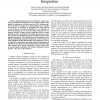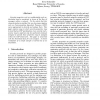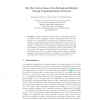ASWEC
2004
IEEE
14 years 6 months ago
2004
IEEE
This paper presents a security characterisation process framework for software components and their compositions in order to address the issue of trust in component based software...
AINA
2004
IEEE
14 years 6 months ago
2004
IEEE
IEEE 802.1x and authentication server based security protocols are mainly used for enhancing security of wireless networks. In this paper, we specify PAP and EAP-MD5 based securit...
DEXAW
2009
IEEE
14 years 6 months ago
2009
IEEE
Abstract--Interdependencies between different security patterns can influence the properties of a particular pattern when applied in conjunction with other patterns. The resulting ...
ESORICS
1994
Springer
14 years 6 months ago
1994
Springer
This paper presents a calculus of channel security properties which allows to analyze and compare protocols for establishing secure in an insecure open network at a high level of a...
SP
1996
IEEE
14 years 6 months ago
1996
IEEE
Security properties such as con dentiality and authenticity may be considered in terms of the ow of messages within a network. To the extent that this characterisation is justi ed...
CSFW
1999
IEEE
14 years 6 months ago
1999
IEEE
Software systems are becoming heterogeneous: instead of a small number of large programs from well-established sources, a user's desktop may now consist of many smaller compo...
POPL
2000
ACM
14 years 6 months ago
2000
ACM
Certified code is a general mechanism for enforcing security properties. In this paradigm, untrusted mobile code carries annotations that allow a host to verify its trustworthine...
NDSS
2000
IEEE
14 years 6 months ago
2000
IEEE
This paper describes automatic protocol generation (APG for short), a novel mechanism to generate security protocols automatically. With APG, the protocol designer inputs the spec...
CSFW
2002
IEEE
14 years 7 months ago
2002
IEEE
We present a formal analysis technique for probabilistic security properties of peer-to-peer communication systems based on random message routing among members. The behavior of g...
CHARME
2003
Springer
14 years 7 months ago
2003
Springer
Intrusion-tolerance is the technique of using fault-tolerance to achieve security properties. Assuming that faults, both benign and Byzantine, are unavoidable, the main goal of Int...



